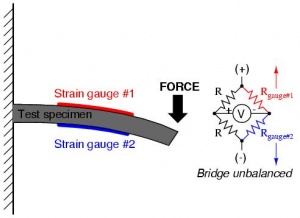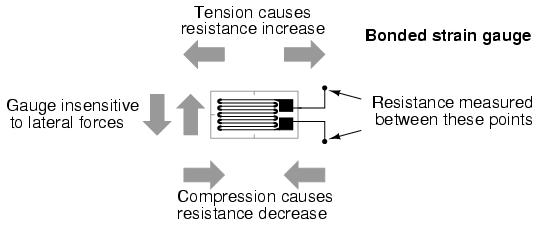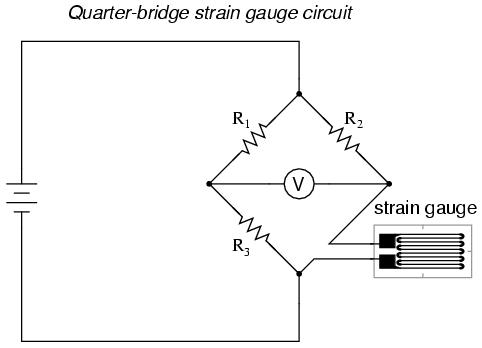Difference between revisions of "Strain Gauge"
m |
|||
| Line 18: | Line 18: | ||
| [[image:advanced strain gauge attachment.jpg|300px]] |
| [[image:advanced strain gauge attachment.jpg|300px]] |
||
|} |
|} |
||
===Example Usage=== |
|||
The FX1901 is an inexpensive 1% strain gauge that can be used for a variety of applications. It is available for about $30 and comes in 10, 25, 50, and 100 lbf models |
|||
[[image:FX1901.jpg] |
|||
[[image:FX1901 Diagram.jpg] |
|||
Connect the + input to Vcc and the - input to Vss. A signal conditioner then needs to be used to get the appropriate gain for output. |
|||
Revision as of 22:50, 6 January 2009
Overview
Strain gauges are simple sensors that can be used to measure forces. They consist peice of conducting material that changes resistance as it is stretched in a given direction. The diagram below shows this:
Circuitry
Typically, the change in resistance of the strain gauge is very small. In order to accurately measure this small change, special circuitry is needed. For this, a wheatstone bridge configuration is usually employed. There are variants on how this circuit can be arranged; two are presented below.
The first configuration is the simplest method. The wheatstone bridge measures small imbalances in the resistances. Here it is comparing the strain gauge resistance to , which has a resistance equal to the resistance of the unstretched strain gauge. The other two resistors should have similar values.
Next is a more advanced circuit used for measuring strain in both directions. Two strain gauges are used, and must be positioned carefully, as shown in the second figure.

|

|
Example Usage
The FX1901 is an inexpensive 1% strain gauge that can be used for a variety of applications. It is available for about $30 and comes in 10, 25, 50, and 100 lbf models
[[image:FX1901.jpg] [[image:FX1901 Diagram.jpg]
Connect the + input to Vcc and the - input to Vss. A signal conditioner then needs to be used to get the appropriate gain for output.


